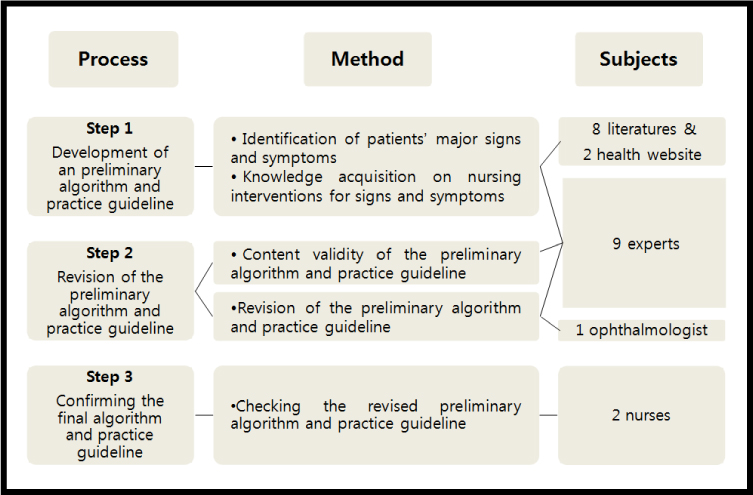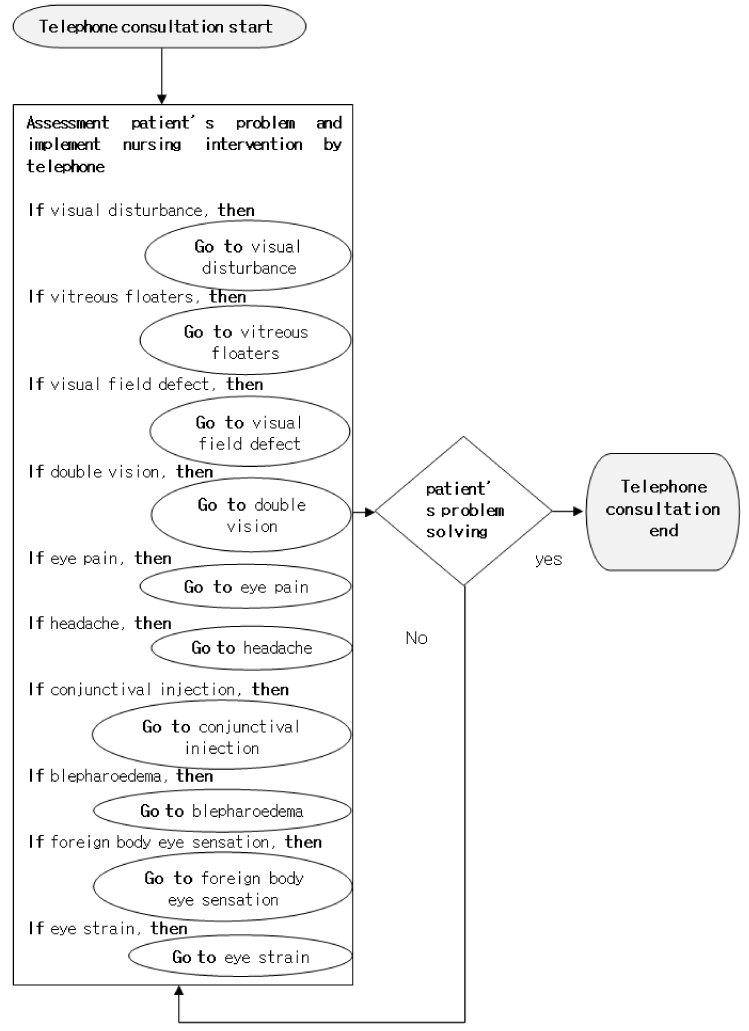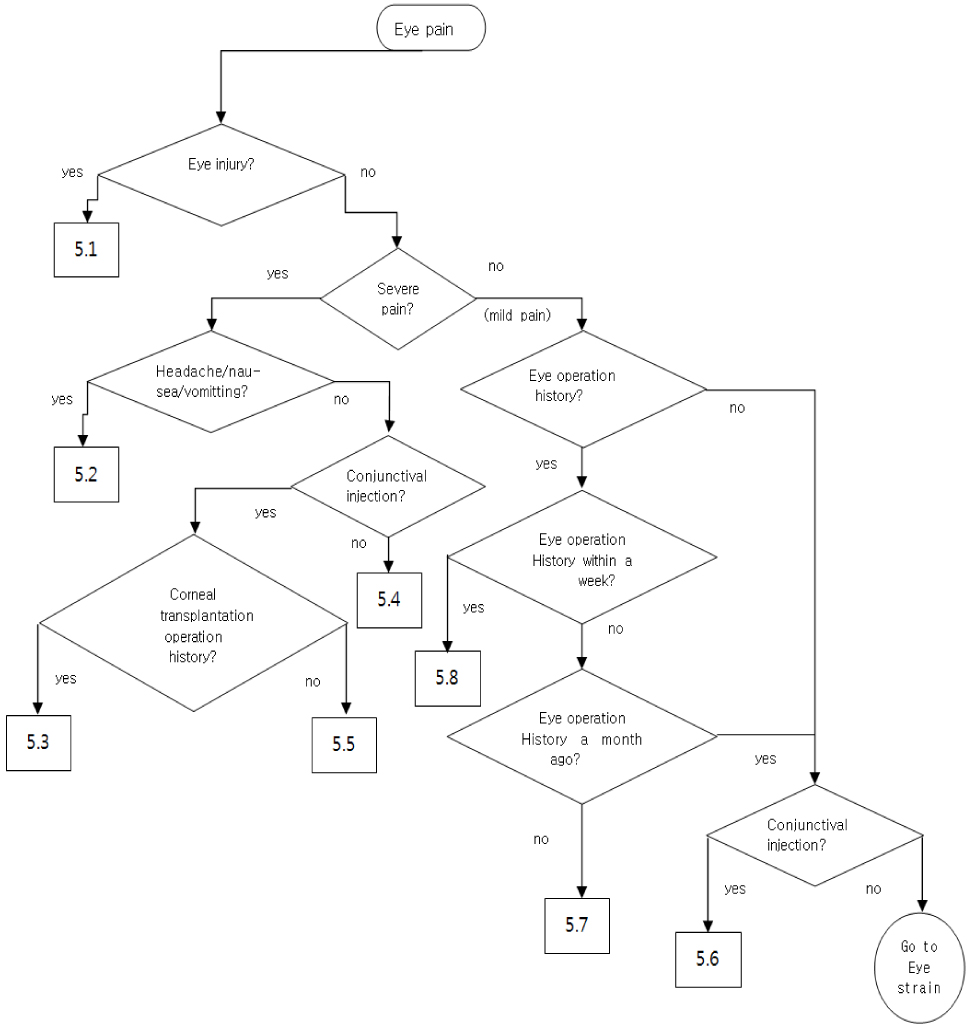J Korean Acad Nurs Adm.
2011 Sep;17(3):336-348.
Development of Telephone Consultation Algorithm for Patient Discharged with Ophthalmic Disease
- Affiliations
-
- 1Department of Nursing, Kyundong University, Korea. hjlee@k1.ac.kr
- 2College of Nursing, Seoul National University, Korea.
Abstract
- PURPOSE
This methodological study was done to develop a telephone consultation algorithms and practice guidelines for patient discharged with ophthalmic diseases.
METHODS
The ophthalmic problems of the patients were identified and expert knowledge on managing the problems was acquired. Algorithms and practice guidelines were developed based on the expert knowledge. The content validity of algorithms and practice guidelines was evaluated by the experts.
RESULTS
The preliminary algorithms and practice guidelines were developed from 60 detailed signs and symptoms and 45 nursing interventions. The experts agreed that 57 detailed signs and symptoms linked with nursing interventions were valid, with the content validity index over 80%. Meeting with nurse experts and ophthalmologists was convened to review the rest of the 3 detailed signs and symptoms linked with nursing interventions. Finally, 60 detailed signs and symptoms and 46 nursing interventions were confirmed.
CONCLUSION
This study suggests that the algorithms and practice guidelines are effective decision-making tools and utilization of these algorithms and practice guidelines is expected to improve the quality of clinical nursing and patient satisfaction.
Keyword
Figure
Reference
-
1. Bridgeman T, Flores M, Rosenbluth J, Pierog J. One emergency department's experience: clinical algorithms and documentation. J Emerg Nurs. 1997. 23:316–325.
Article2. Dong SL, Bullard MJ, Meurer DP, Blitz S, Holroyd BR, Rowe BH. The effect of training on nurse agreement using an electronic triage system. CJEM. 2007. 9(4):260–266.
Article3. Emergency Medical Information Center. Counseling booklet in first aid. 2008. Seoul: Emergency Medical Information Center.4. Greenberg ME. A comprehensive model of the process of telephone nursing. J Adv Nurs. 2009. 65(12):2621–2629.
Article5. Jang HS. A study of telephone advice and nursing intervention in a general hospital outpatient department. 1999. Seoul: Ewha Womans University of Korea;Unpublished master's thesis.6. Kang HJ, Han KJ, Choe MA, Park SH, Kim YM, Kwon WK, et al. An investigational study on telephone calls to the pediatric nursing unit. Korean J Child Health Nurs. 1996. 2(1):112–126.7. Kang SJ. The effects of phone counseling on maternal role in primiperous mothers. Korean J Child Health Nurs. 2001. 7(4):405–420.8. Kanski JJ. GH Jin IG Park SY Yoo UH Nam HU Kwak . Clinical ophthalmology. 2005. Seoul: Jungdam Publishing Company.9. Kim JJ, Noh YJ, Choi YH, Kim MJ. Medical surgical nursing. 2000. Seoul: Hyunmoonsa.10. Kim KJ, Lee HY, Goh GJ, Kim JH, Wang MJ, Choi GO, et al. Manual of emergency care. 2001. Seoul: Hyunmoonsa.11. Kim KJ, Lee HY, Kim GB, Wang MJ, Park KS, Shon IA, et al. Emergency nursing: A physiologic and clinical perspectives. 1998. Seoul: Hyunmoonsa.12. Ko YM. A study of thesaurus based ontology. Inf Manag. 2006. 5:5–22.13. Korean Academy of Home Care Nursing. Stress in home health care advanced practice nurses experiences of telephone consultation. J Korean Acad Soc Home Care Nurs. 2005. 12(2):33–44.14. Lee EO, Choi MA, Park SY, Lee SO, Song MS, Kim DS, et al. Medical surgical nursing. 2002. Seoul: Shinkwang Publishing Company.15. Lee HJ, Park HA. Telephone inquiries to the ophthalmology nursing units and nursing interventions through telephone consultations. J East West Nurs Res. 2009. 15(2):157–167.16. Lee HY, Choi CJ, Park OJ, Kim KS, Choi KO, Kim KS, et al. Adult health nursing. 2010. 6TH ed. Seoul: Soomoonsa.17. Lee JH. A clinical-decision support system for the nursing process for the major signs and symptoms seen in primary and secondary school students. 2007. Seoul: Seoul National University of Korea;Unpublished master's thesis.18. Lee SK, Song MR, Kwon EG, Yu HA, Lee SS, Jung JY, et al. The development of a telephone triage protocol for outpatient department(OPD) nurses: for patients with chest pain. Clin Nurs Res. 2002. 8(1):73–88.19. Letourneau MA, MacGregor DL, Dick PT, McCabe EJ, Allen AJ, Chan VW, et al. Use of a telephone nursing line in a pediatric neurology clinic: one approach to the shortage of subspecialist. Pediatrics. 2003. 112(5):1083–1087.
Article20. Lynn MR. Determination and quantification of content validity. Nurs Res. 1986. 35(6):382–385.
Article21. National Health Insurance Corporation. 2008 statistics of major surgery. 2009. Seoul: National Health Insurance Corporation.22. Nauriqht LP, Moneyham L, Williamson J. Telephone triage and consultation: an emerging role for nurses. Nurs Outlook. 1999. 47(5):219–226.
Article23. Park MO. Development of a nursing practice guideline for pre & post-operative care of gastric cancer patient. 2009. Seoul: Seoul National University of Korea;Unpublished master's thesis.24. Wahlberg AC, Cedersund E, Wredling R. Telephone nurses' experience of problems with telephone advice in Sweden. J Clin Nurs. 2003. 12(1):37–45.
Article25. Yang JJ. Development and application of the algorithm for emergency nursing care of dyspneic patients. 2005. Gwangju: Chonnam National University of Korea;Unpublished doctoral dissertation.26. Yoon DH, Lee SW, Choi E. Ophthalmology. 2005. Seoul: Ilchokak.
- Full Text Links
- Actions
-
Cited
- CITED
-
- Close
- Share
- Similar articles
-
- A Study on the follow-up care program for the discharged chronic ill patients
- Crossmapping of Nursing Problem and Action Statements in Telephone Nursing Consultation Documentations with International Classification for Nursing Practice
- Development and Evaluation of Standardized Telephone Counseling Guidelines on Symptom Management for Patients Discharged after Colorectal Cancer Surgery
- Physicians’ perception toward using telephone consultations during the COVID-19 pandemic in Korea
- Telephone follow-up care for disabled patients discharged after receiving dental treatment under outpatient general anesthesia




